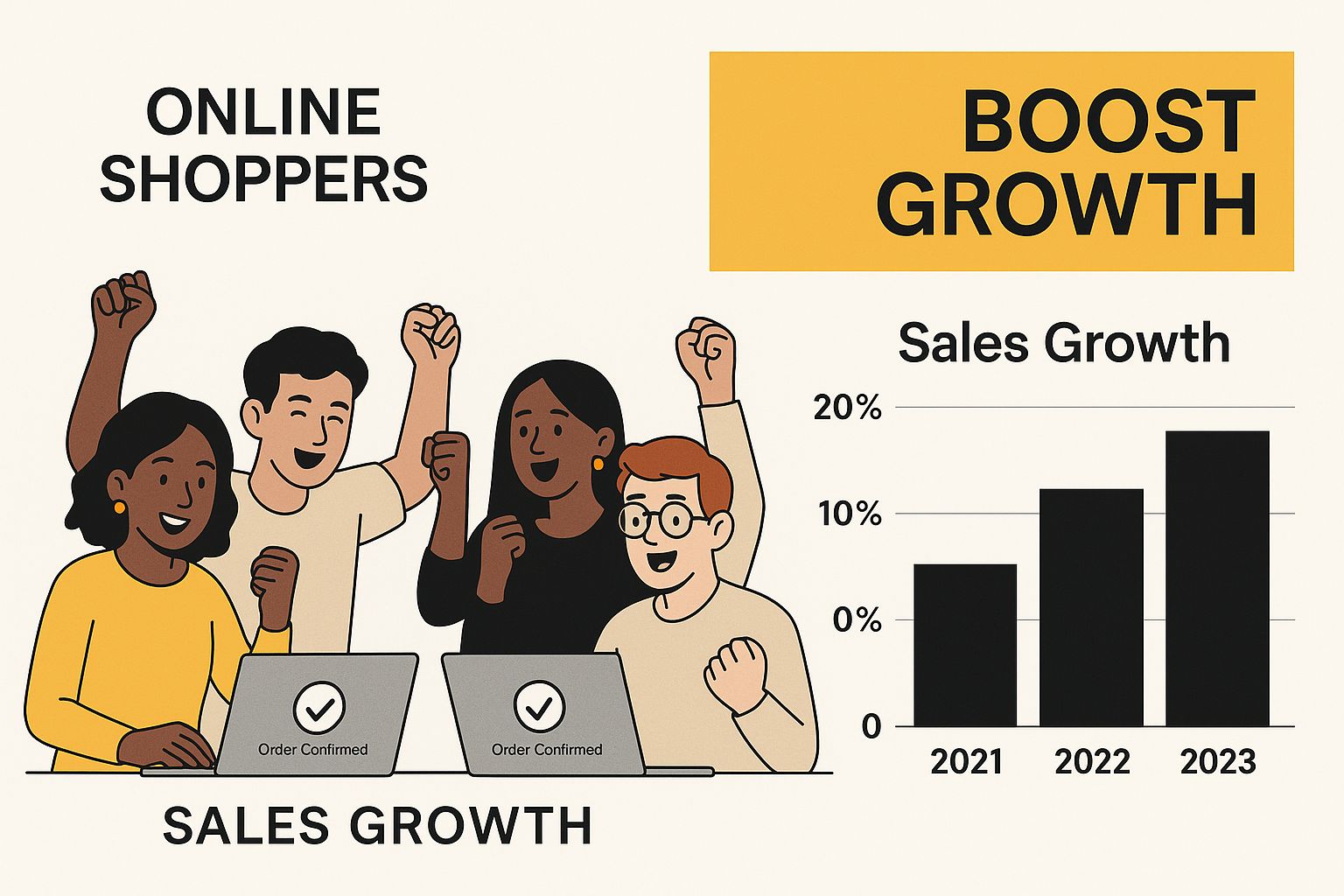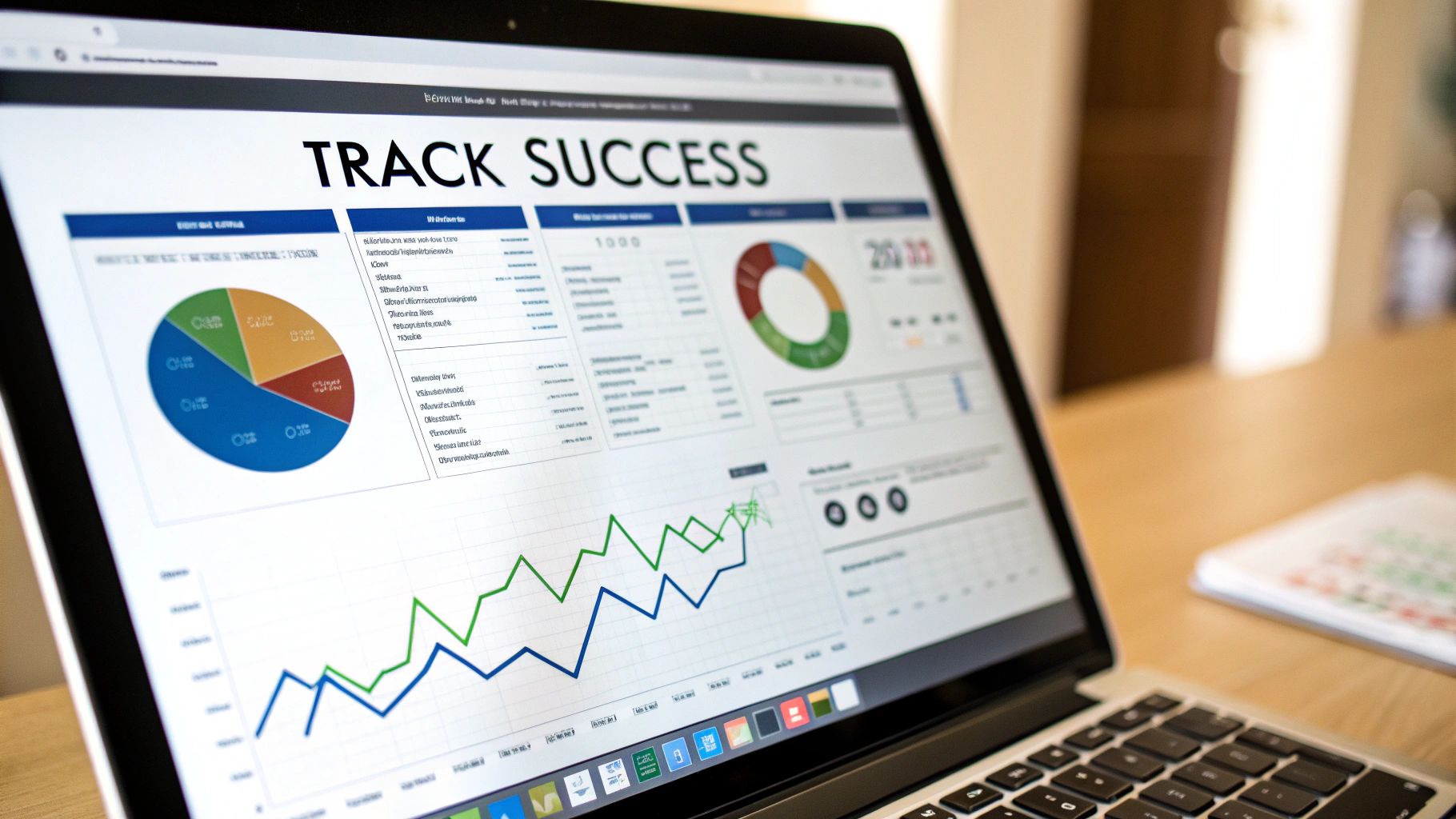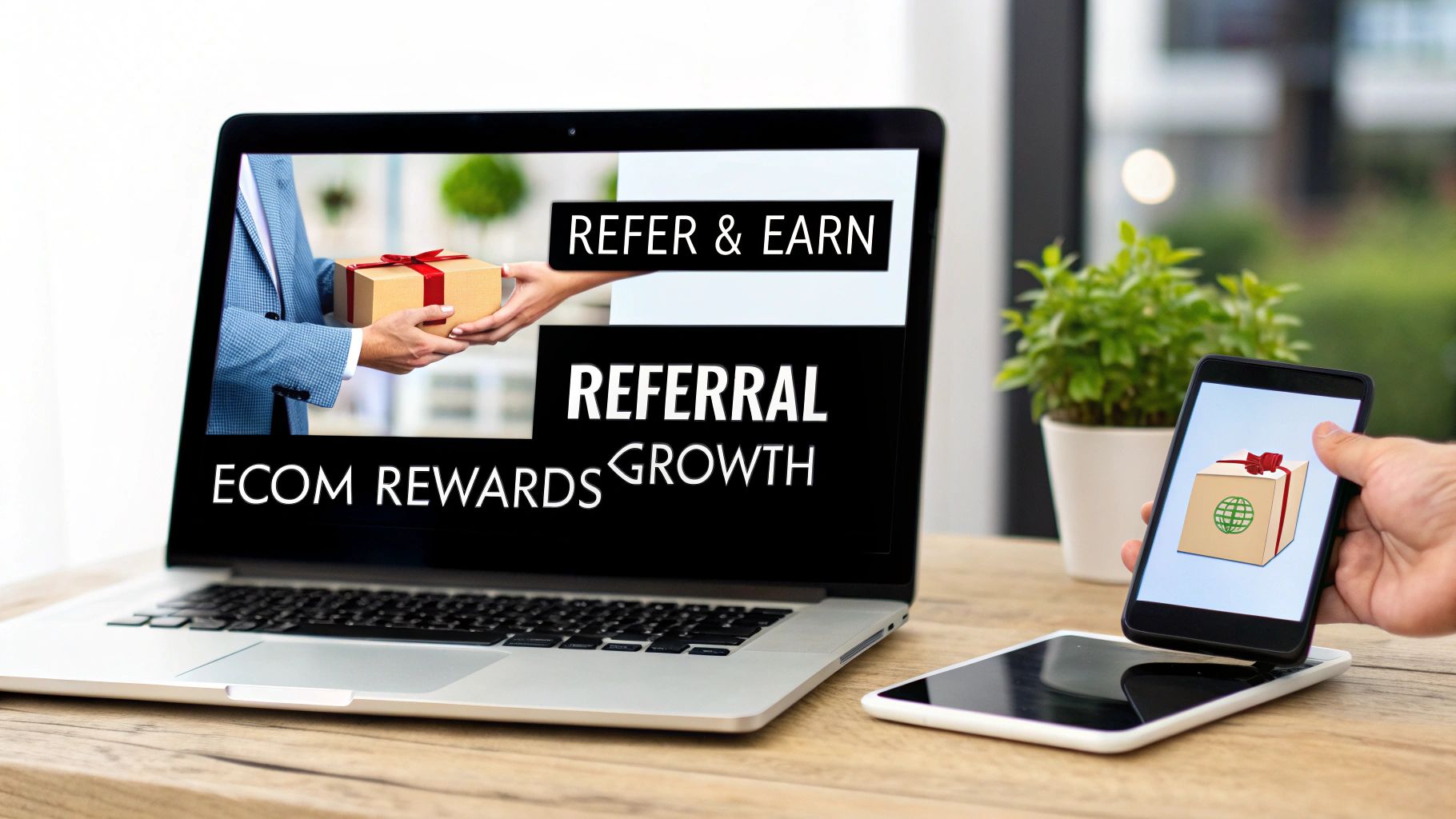At its core, an ecommerce referral program is just a structured way to thank your customers for telling their friends about you. It's a marketing system that rewards them when their recommendation turns into a sale.
This simple idea transforms your happiest buyers into a genuine, high-converting sales force. You're basically putting word-of-mouth marketing on steroids.
Why a Referral Program Is Your Next Growth Engine
Let's be honest—relying solely on paid ads to find new customers is getting tougher and more expensive every day. Ad costs are climbing, and people are getting better at tuning them out. Brands need a smarter, more sustainable way to grow.
This is exactly where a well-designed referral program shines. It turns your existing customer base into an authentic and powerful channel for bringing in new business. Instead of just blasting ads out into the world, you’re letting your most passionate customers share their genuine experiences. It’s not just about saving a few bucks on ad spend; it's about acquiring better-quality customers who show up already trusting you.
The Real Impact of Referred Customers
The value of a referral is so much more than just that first purchase. Customers who find you through a recommendation are not only cheaper to acquire, but they also tend to stick around longer and spend more.
They often show much higher loyalty and are far more likely to become brand advocates themselves. This kicks off a powerful, self-sustaining growth loop. A great referral program is a key piece of broader strategies for creating customer loyalty programs, turning happy buyers into your biggest fans.
Time and time again, the data proves that referred customers are just better. They walk in the door with a built-in layer of trust, which dramatically shortens the path to purchase and boosts conversion rates compared to cold traffic from an ad.
Driving Measurable Growth and Loyalty
The numbers don't lie. Referral programs in eCommerce consistently pull in 3 to 5 times greater conversion rates than other marketing channels.
As of early 2025, we're seeing that referred customers have a 16% higher lifetime value and a 37% higher retention rate. On top of that, these customers are about four times more likely to refer someone else, which is how you get that incredible cycle of growth going.
Before you jump in, it's a good idea to get familiar with the fundamentals. For a more detailed breakdown, our guide on building a referral program is the perfect place to start.
Designing Incentives That Actually Motivate
Let's be honest: the reward is the engine of your referral program. If it doesn't spark genuine excitement, even your most die-hard fans won't bother sharing. To get this right, you need to design incentives that feel valuable, relevant, and worth the tiny bit of effort it takes to send a link.
A lot of brands just throw a percentage discount out there and call it a day, but that’s barely scratching the surface. The best rewards are a bit more clever—they tap into customer psychology and align perfectly with your brand's vibe and price point. Your goal is to find that sweet spot between what gets your customers clicking and what makes sense for your bottom line.
Just look at how powerful a well-thought-out program can be for growth.

As you can see, this isn't just a "nice-to-have" marketing channel. It can quickly become a cornerstone of how you acquire new customers.
Choosing Your Ecommerce Referral Incentive Structure
So, what kind of reward should you offer? The best approach depends entirely on your business model and what your customers value most. A one-size-fits-all strategy rarely works here. This table breaks down the most common incentive types to help you decide.
| Incentive Type | Best For | Pros | Cons |
|---|---|---|---|
| Store Credit | Brands focused on repeat business and high LTV. Think consumables like coffee, supplements, or skincare. | Drives repeat purchases, keeping revenue within your ecosystem. Often perceived as higher value than its actual cost. | Less appealing for one-time purchase or high-ticket items. Only useful for existing customers. |
| Percentage Discount (%) | Businesses with a wide range of product prices or those who want a simple, scalable offer. | Easy to understand and implement. Scales automatically with order value. Very common and familiar to customers. | Can devalue your brand if overused. May not be a strong enough motivator for lower-priced items. |
| Fixed Cash Amount ($) | High-ticket items (e.g., mattresses, furniture) or subscription services where the LTV is high. | Extremely motivating and straightforward. Can be paid out via platforms like PayPal, making it feel "real." | Can be expensive and complex to manage payouts. Doesn't encourage repeat purchases from the advocate. |
| Tiered Rewards | Companies with a highly engaged community or those wanting to gamify the referral process. | Encourages multiple referrals and sustained effort. Creates a sense of achievement and exclusivity. | Can be complex to set up and track. May only appeal to your most dedicated superfans. |
| Exclusive Products/Access | Hype-driven brands with loyal followings (e.g., fashion, collectibles, gaming). | Creates a strong sense of insider status and community. Can be very low-cost to fulfill (e.g., digital goods). | Appeal is limited to your core audience. Not a universal motivator like cash or discounts. |
Ultimately, the right structure is one that feels generous to your customers while still being profitable for you. Don't be afraid to test different offers to see what resonates.
The Power Of The Double-Sided Incentive
Here’s a pro tip: the most successful referral programs reward both people. The person sharing gets a thank you, and their friend gets a welcome gift. This simple "give-a-little, get-a-little" approach is crucial because it removes any awkward, salesy feeling for the advocate.
This two-way street is the industry standard for a reason. In fact, over 78% of referral programs are double-sided. We know from recent data that 65% of new business opportunities in ecommerce are sparked by referrals, and that participation is fueled by these compelling, fair incentives. If you want to dive deeper into the numbers, check out the research on modern ecommerce referral programs from 99minds.io.
A great double-sided offer feels less like a transaction and more like a genuine gift from one friend to another. It transforms your advocate from a salesperson into a helpful resource.
Imagine a supplement company offering $25 in store credit to the advocate while giving their friend 25% off their first order. It’s a classic win-win. This structure is simple, feels fair, and is incredibly effective at getting new customers to actually make a purchase.
Setting Up a Seamless Referral Experience

Even the most generous incentive will fail if your referral process is a pain to use. Your goal here is to make sharing feel like a complete no-brainer. If a customer ever has to pause and think, "Wait, what am I supposed to do now?" you've probably already lost them.
This is where the right software becomes the backbone of your referral program for ecommerce. A platform like Refgrow is built to plug directly into your store, making the program feel like a core part of your brand—not some clunky, third-party add-on. That seamless integration is absolutely vital for building trust and ensuring the experience is smooth for both your loyal customer and the friend they're referring.
A great setup handles all the grunt work for you. It generates the unique links, tracks every click, and correctly attributes sales, freeing you up to focus on strategy.
Crafting a Compelling Referral Landing Page
Think of your referral landing page as the program's elevator pitch. It has about five seconds to answer two critical questions: "What's in it for me?" and "How do I get started?" Anything more complicated is just noise.
Start with a headline that screams value. Don't just say, "Our Referral Program." Instead, try something direct like, "Give Friends 20% Off & Get $20." Right away, everyone knows what they stand to gain.
To build a page that actually converts, make sure you nail these elements:
- A Clear Headline: Explains the benefit instantly.
- Simple Instructions: Show how it works in 2-3 quick, visual steps. Keep it simple.
- An Obvious Call-to-Action (CTA): Use a big, bold button that says something like "Get My Referral Link" or "Start Sharing."
- A Dash of Social Proof: A quick note like, "Join 1,000+ happy customers earning rewards!" can make a huge difference.
This page needs to be the central hub for your entire program. Make it easy to find from your main menu, customer account pages, and especially in your post-purchase emails.
Your landing page is a quick-start guide, not a legal document. The entire point is to get that unique sharing link into your customer's hands as fast as humanly possible. Save the fine print for another page.
Making the Sharing Process Effortless
Once someone is ready to share, the process itself needs to be frictionless. I've seen too many programs fail because they expect customers to manually copy and paste a long, ugly URL. Don't make that mistake.
The best approach is to provide a handful of one-click sharing options that align with how people actually talk to their friends.
Give them a suite of easy-to-use tools right on the page:
- Email: Have a pre-written, friendly email template ready to go. All they should have to do is type in a friend's address and hit send.
- Social Media: Integrate direct share buttons for Facebook, X (formerly Twitter), and Pinterest.
- Messaging Apps: Buttons for WhatsApp and Messenger are non-negotiable, as this is where most personal recommendations happen today.
- Copy Link Button: And for everything else, a simple one-click button that copies their unique link to their clipboard is a must-have.
This multi-channel approach removes all the technical hurdles. It lets your advocates use the platform where they feel most comfortable, drastically increasing the odds that they'll actually follow through. You're turning their goodwill into real growth for your business.
Promoting Your Program to Drive Real Engagement
You’ve built the program, set your commissions, and flipped the switch. Now what?
A mistake I see all the time is brands launching a beautiful referral system and then just... waiting. They expect customers to magically find it. But that's not how it works. To get real results, you need to actively and consistently promote your program.
Think of your referral program as a new product. It needs its own marketing plan. You have to weave it into the customer journey so your best customers can't miss it.
Find Your High-Impact Placements
First things first, let's figure out where to put your referral offer. Instead of just slapping a generic banner on your homepage, you need to find the spots where your customers are happiest and most engaged. These are your golden opportunities to ask for a share.
Here are a few of the most effective places to plant your referral CTAs:
- The Post-Purchase Page: This is prime real estate. The customer just bought from you. Their excitement is at its peak. This is the perfect moment to hit them with a clear, compelling offer like, "Love your new gear? Give friends 20% off and get $20."
- Customer Account Dashboards: Your most loyal, repeat customers live here. Make sure there’s a permanent, easy-to-find link or banner in their account area. These are your future super-advocates.
- Transactional Emails: Don't just rely on a big launch email. Slip a clean, simple banner promoting the program into the bottom of every order confirmation, shipping update, and delivery notice.
By integrating your program into these key touchpoints, it stops being a hidden page and becomes a natural part of the buying experience.
Craft Compelling Email and Social Campaigns
Those on-site placements are great for passive promotion, but you need to get proactive to really build momentum. A dedicated email campaign is an absolute must-have when launching your referral program for ecommerce.
Kick things off with a launch announcement that spells out the benefits crystal clear. Make the "what's in it for me" obvious for both the person sharing and their friend. Try a subject line that gets straight to the point, like "Share the Love & Get Rewarded."
A single email blast won't cut it. You need a sequence. Send a reminder a week after your launch. Then, get a little smarter by segmenting your list to target customers who have made multiple purchases but still haven't signed up to refer.
Over on social media, you can have a little more fun with it. Run a contest where followers share their unique referral links for a chance to win a bigger prize, or showcase user-generated content from customers who cashed in on a referral. The goal is to make sharing feel like a fun community event, not a clunky marketing request.
This transforms your program from a simple tool into a powerful engine that drives both engagement and brand new customers.
How to Measure and Optimize Your Program

Getting your referral program live is a huge first step, but the real work starts now. Think of the launch as day one. The true value comes from treating your program not as a static feature, but as a living, breathing part of your marketing engine that you can constantly tune for better performance.
A "set it and forget it" mindset is a surefire way to leave money on the table. Instead, the most successful programs are those that are consistently measured, tweaked, and improved over time.
Your referral software’s dashboard is your command center. This is where you'll find the data that tells the story of what's working, what's falling flat, and where your biggest opportunities lie. The goal isn't just to count referrals; it's to understand the behaviors that lead to them.
Pinpointing Your Key Performance Indicators
To get a clear picture of your program's health, you need to focus on a handful of crucial metrics. Trying to track everything at once is a recipe for analysis paralysis. These are the numbers that truly matter.
Participation Rate: What percentage of your customers have actually signed up to be advocates? A low number here is a red flag. It could mean your program isn't visible enough, or maybe the initial offer just isn't exciting.
Share Rate: Of the customers who signed up, how many are actually sharing their link? This is a direct measure of advocate engagement. If people are signing up but not sharing, you need to find out why.
Referral Conversion Rate: This is the big one. What percentage of referred friends are clicking the link and making a purchase? If your share rate is high but this number is low, it often points to a problem with your referral landing page or the offer for new customers.
Customer Acquisition Cost (CAC) via Referrals: This one is simple but powerful. Just divide your total reward costs by the number of new customers you've acquired. This figure should be dramatically lower than your CAC from paid ads.
Tracking these KPIs lets you move from guessing to knowing. Instead of wondering why your program is underperforming, you can pinpoint the exact stage in the funnel that needs attention. For more context on building a high-performing program, be sure to review these referral program best practices.
Key Referral Program Metrics to Track
Here’s a quick-reference table summarizing the essential KPIs for measuring your referral program's success and what each one tells you about your performance.
| Metric | What It Measures | Why It's Important |
|---|---|---|
| Participation Rate | The percentage of total customers who join the program. | Shows the initial appeal and visibility of your offer. |
| Share Rate | The percentage of enrolled advocates who share their link. | Measures advocate engagement and motivation. |
| Conversion Rate | The percentage of referred friends who become customers. | Indicates the effectiveness of your landing page and offer. |
| CAC via Referrals | The cost to acquire a new customer through referrals. | Proves the program's cost-efficiency vs. other channels. |
Monitoring these four metrics consistently will give you a clear, actionable overview of your program's health and guide your optimization efforts effectively.
Driving Continuous Improvement Through Testing
Once you have a baseline for your KPIs, you can start making things better. This is where A/B testing becomes your best friend. The concept is straightforward: change a single element for a segment of your audience and measure its performance against the original.
A successful referral program is never truly "finished." It's a living part of your marketing that evolves based on real customer behavior. Consistent, small tweaks based on data will always outperform a one-time perfect launch.
Focus your initial tests on the parts of your program that can have the biggest impact on your bottom line.
What to A/B Test in Your Referral Program:
- The Reward Structure: Pit store credit against a percentage discount. You might be surprised to find that a $20 credit feels more concrete and converts better than 15% off, even if the dollar value is similar.
- Landing Page Headlines: Try out different messaging for referred friends. Does a personal-sounding headline like "Your Friend Sent You 20% Off!" outperform a more standard "Welcome! Here’s 20% Off Your First Order"?
- Promotional Email Subject Lines: See what gets more advocates to open your emails and share. Test a direct call to action ("Get $20 for Referring a Friend") against something more community-focused ("Share the Love & Earn Rewards").
The ripple effects of a well-tuned referral program go far beyond customer acquisition. These aren't just any new customers; they're often your best. In fact, customers acquired through referrals have a 25% higher lifetime value, highlighting the quality of growth this channel drives. To truly master optimization, it's also helpful to understand the broader landscape of key user retention metrics that inform your strategy.
Your Top Referral Program Questions, Answered
Even the best-laid plans can hit a few snags, and when you're launching a referral program, questions are totally normal. Let's walk through some of the most common ones we hear from store owners, so you can move forward with confidence.
How Much Should I Actually Offer as a Reward?
The perfect reward isn't a random number—it's tied directly to your store's finances. A solid rule of thumb is to start with 10-20% of your Average Order Value (AOV). So, if your AOV is $100, a $15 or $20 reward in store credit is a pretty compelling reason for someone to share.
But here's the most important part: the total cost of the reward (for both the person referring and their friend) absolutely must be less than your Customer Acquisition Cost (CAC). This is non-negotiable. It’s what keeps your program a profitable growth engine instead of just another expense.
When Is the Perfect Moment to Ask for a Referral?
Timing is everything. You have to strike when the iron is hot—when your customer is feeling great about their purchase. Think about those "moments of delight."
The best times to ask are right on the order confirmation page, immediately after a fantastic customer support chat, or in a follow-up email a week after they've received and started enjoying their product.
Set up automated emails triggered by these events. It’s a low-effort, high-impact way to keep the referrals flowing in without you having to lift a finger. Don't let these prime opportunities pass you by.
Can a Referral Program Really Work for a Brand-New Store?
You bet it can. For a new store, a referral program is like a growth hack on steroids. Your customer base might be small at first, but those early adopters are often your most passionate supporters. They want you to succeed.
A referral program simply gives them an easy, structured way to shout about your brand from the rooftops. It helps you build that all-important social proof and brings in your first wave of customers for a fraction of what you'd spend on ads. For some great ideas, check out these powerful referral program examples from brands that are crushing it.
Ready to turn your happy customers into your most powerful marketing channel? With Refgrow, you can launch a fully native, customizable referral program in just minutes. Ditch the high ad spend and start building a growth engine that runs itself. Get started with Refgrow today.

